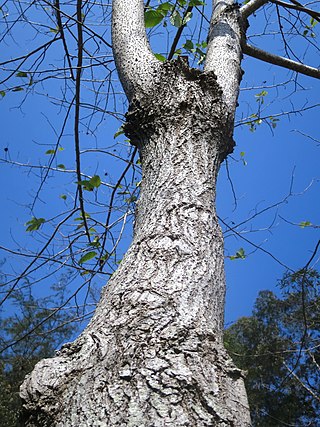Camptotheca acuminata
Species of aquatic plant From Wikipedia, the free encyclopedia
Camptotheca acuminata is a species of tree in the Camptotheca genus that is native to north Vietnam and southern China.[1] It is also cultivated in the southern United States.[2]
| Camptotheca acuminata | |
|---|---|
 | |
| Trunk of the tree | |
| Scientific classification | |
| Kingdom: | Plantae |
| Clade: | Tracheophytes |
| Clade: | Angiosperms |
| Clade: | Eudicots |
| Clade: | Asterids |
| Order: | Cornales |
| Family: | Nyssaceae |
| Genus: | Camptotheca |
| Species: | C. acuminata |
| Binomial name | |
| Camptotheca acuminata Decne. Bull. Soc. Bot. France 20: 157 (1873) | |
A eudicot,[3] it is a flowering deciduous tree with light gray bark.[4] It can grow to a height of 20 metres (66 ft). Its large, papery leaves are somewhat oval in shape, usually 12 to 28 cm (5 to 10 in) long and 6 to 12 cm (2 to 5 in) wide.[4] The flowers, which bloom from May through July, produce a gray-brown fruit with one seed in September.[4]
Uses
Camptotheca acuminata is a source of camptothecin chemicals, which have been tested for potential use as treatments for cancer and HIV.[2] The modern chemotherapy drugs topotecan and irinotecan are derived from it, though now the molecules are produced in a lab environment rather than extracted from the leaves and bark of the tree.[5] Because of this, it is sometimes called the "cancer tree".[5]
In traditional Chinese medicine, the tree is called xi shu ("tree of joy" or "happy tree") and was considered a relatively unimportant[5] medicinal plant.[2][5]
The tree is also grown for shade and ornamental value.[5]
References
Further reading
Wikiwand - on
Seamless Wikipedia browsing. On steroids.




